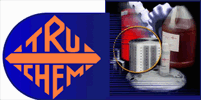

|
T.C. 223 |
||||||
|
||||||
 |
 |
|
| MISSION STATEMENT | HOME |
|
|
PRIMARY APPLICATIONS T.C. 223 is a liquid consisting of a blend of alkalis, chelating agents and low-foaming surface active agents. This balanced blend of ingredients functions as:
PRODUCT FEATURES
APPLICATION PROCEDURE Aluminum Etching Precleaning If soil is light, precleaning will often not be needed. T.C. 223 will remove light oil. Where the aluminum is covered with considerable soil and stencil ink, a separate cleaning operation before etching may be desirable. T.C. 206 or T.C. Brightener can be used. These products have the advantage of being single step processes. If standard alkaline cleaners such as T.C. 208 or T.C. 206 Aluminum Cleaner are used to preclean, deoxidizing after cleaning and before etching is generally necessary. Etching
Etching Solution Control If T.C. 223 is made up on a weight basis, the conversion factor is 1.1. The concentration of the solution will be in oz./gal. of active etchant. Etching Solution Upkeep The period for replacing the etching solution may be extended almost indefinitely by a constant bleed-off and a continuous input of fresh T.C. 223. Using this procedure, a uniform etching rate can be maintained by holding the aluminum salt concentration constant, generally 4 to 6 oz./gal., and keeping the proper T.C. 223 concentration. Paint Stripping T.C. 223, as a paint stripper, offers the convenience of a liquid, the ability to remove pigment residues and the property of good rinseability. T.C. 223 can be used full strength or reduced with water. The work can be carried out by tank immersion or hot flow-on. Application Full strength - Used full strength at room temperature or up to 160°F, T.C. 223 is an economical paint stripper for use on such paint films as may be readily removable by alkaline strippers. Solution Use T.C. 223 at 5% to 25% by volume with water. The temperature is maintained as close to the boiling point as possible. Adjustments in concentrations and temperature can be made to meet individual conditions. The many classes of paints and variations within each class of paint necessitate testing before firm recommendations are made. Often paint types that are considered highly resistant, such as epoxies, are at times modified to such an extent with other resins that although they retain their classification, they lose much of their resistant properties. The stripping of such paint films may not require costly solvent type strippers. Neutralizing Acid Wastes Disposal of acid waste is controlled by local regulatory authorities. Before acid waste is allowed to enter the sewage lines, often it must be neutralized with an alkaline material to bring the pH up to a specified range, usually pH 6.0 - 8.0. A common practice is to shovel a dry alkali material into a settling tank containing the acid waste. Comparing cost of materials, this method seems, on paper, the least expensive. However, in practice, the cost picture changes. Often a substantial portion of the dry material settles out in the bottom of the tank and is wasted. Additional material is required to obtain the proper pH. T.C. 223 is 100% efficient. Every ounce of T.C. 223 added to acid waste is active. The operation, as outlined below, is quick and simple.
Cleaning Railroad Trucks, Underframes and Running Gear The versatility and heavy duty cleaning ability of T.C. 223 lends itself well for removing dense accumulation of road grime, oil, caked grease, carbonaceous, and other difficult-to-remove soils found on railroad trucks, underframes and running gear. Using a 5% to 8% by volume concentration, spray onto the surface by using high pressure spray equipment. Let soak for short time then follow with hot or cold water pressure rinse. For faster cleaning action, heat solution to between 140° to 160°F. With heat, the solution can be further diluted. With a steam gun, effective action is maintained with concentrations of 1% to 2% by volume. On painted surfaces, low concentrations in the order of 2% by volume are used as the starting test point to check the effect of the solution on the paint. Cleaning in Paper Mills The rapid action of T.C. 223 on resinous materials and its ability to convert these polymers into a form that is easily flushed away, is of prime value in cleaning paper mill systems. The accumulation in the system of resinous matter such as pitch, size and resin must be removed periodically. This is accomplished as follows: Stock Systems Use T.C. 223 at 1% to 6% by volume with water at room temperature. Heat if necessary to remove chill from water. Re-circulate through stock system. Finish with a fresh water, re-circulated flush. T.C. 223 may be used with or without the addition of T.C. Additive, depending on the extent of cleaning required. In most instances, T.C. 223 alone is satisfactory. Suction Rolls T.C. 223 at 3% to 5% by volume heated to 140°F to 160°F is circulated on rolls in place. The cleaning operation is followed by thorough rinsing. SOLUTION CONTROL Will be supplied by Tru-Chem Company Inc. DISPOSAL T.C. 223 generally does not present a disposal problem. Some localities may require neutralization and dilution. T.C. 223 is biodegradable. HANDLING T.C. 223 is a heavy duty alkaline material. The same normal handling care should be exercised with T.C. 223 as with all highly alkaline products. CHARACTERISTICS T.C. 223 is a blend of alkalis, low foaming wetting agents and chelating agents.
STORAGE Indoor storage during cold weather is desirable. At a temperature below 45°F, the product crystallizes but returns to normal condition on thawing and mixing without any effect on the product's performance. The thawing can be quickened by applying heat or simply moving the drum to a warmer area in the plant. ACTION ON METALS
PACKAGING
|